Exercises for Hyperlordosis
1 Hip flexors stretch (Thomas)


Lie on your back with your buttock at the edge of a table with your knees pulled toward your chest.
Then, pull one knee as close as possible to your chest.
Slowly straighten the free leg so it is off the edge and let the knee relax to feel a stretch at the front of the hip.
When you’re done, bring the knee back up to protect the lower back.
2 Supine hip flexor stretch
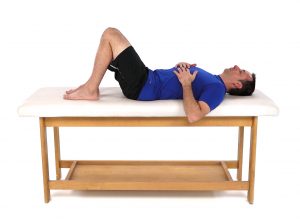

Lie on your back on a bed or table with your body angled off to the side.
Pull your knees to your chest and lower one leg off the bed/table.
Bring your other knee up towards your chest until you feel a stretch in front of the leg lying outside the bed.
Maintain the stretch and slowly return to the initial position by bringing the leg back to the table.
3 Hip flexors stretch (static)


Kneel on one knee creating a 90° angle with the opposite hip and use a chair for support.
Tilt your pelvis backwards to flatten your lower back and transfer your weight forward until you feel a gentle stretch on the anterior aspect of your hip of the lower leg.
Maintain the position and relax.
Maintain your upper body upright and your lower back flat (not arched).
4 Iliopsoas stretch


On one knee, begin to transfer or push your pelvis forward with your upper body upright
Hold for 30 seconds then repeat.
5 Hip flexion with ER bias


Assume a half-kneeling position with the forward knee slightly abducted (the hip slightly externally rotated away).
Keep lumbar neutral (chest tall). You can pry the knee outward with the same-side elbow.
Hold the position.
6 Stretching iliopsoas


Stand with your feet staggered and the back knee slightly bent.
Tilt your pelvis backward and slowly bring your weight forward onto your front leg until a stretch is felt in front of the hip.
Keep the back in a neutral position for the stretch.
Maintain the position for the recommended time.
7 Assisted lumbar flexion


Wrap your hands around your knees and pull them towards your chest.
Raise your head and shoulders off the floor and bring them towards your knees.
8 Back muscles stretching


Start on all fours.
Round your back by pushing down on your hands, and hold the position for the recommended time.
Without moving your hands, lower your buttocks onto your heels. Then move your hands forward.
Hold the stretch for the prescribed time.
9 Single leg glute bridge
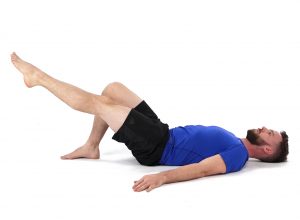

Start in crook lying.
Lift on leg off the floor and go up into a shoulder bridge, peeling one vertebrae at a time.
Keeping the leg out straight and the thigh in line with the other thigh, lower yourself on the ground and lift yourself back up, peeling one vertebrae at a time.
10 Strengthening glutes
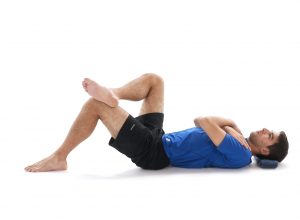

Lie on your back with your knees bent and one leg crossed over the other.
Contract your abdominal muscles and your buttocks while lifting your buttocks off the ground until your trunk is aligned with your supporting leg.
Slowly return to the initial position and repeat.
11 Unilateral glute bridge
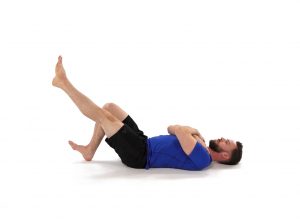

Lie on your back with your knees bent.Extend one knee, keeping your thighs parallel.Squeeze your buttocks together and lift them off the ground to make a straight line with your body without rotating the trunk or hips.Slowly lower your body and repeat.Your head, shoulders and feet are the points of contact on the ground in the high position.Either have your foot completely on the ground or only your heels.
13 Unilateral bridge on ball
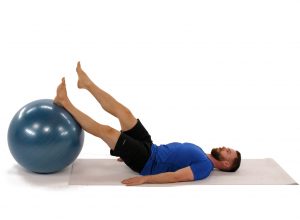
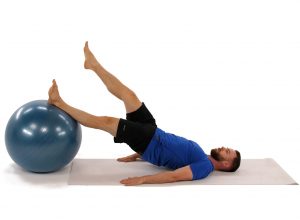
Lie on your back with one of your ankles on a ball, the other leg straight off the ball and your back in neutral position (slightly arched). Activate your lower abdominals (transversus abdomini) by bringing your belly button inward and by activating your pelvic floor muscles (inner thigh) 20 to 30% of maximal contraction.Maintain a steady abdominal breathing while you lift your pelvis off the floor, keeping your back straight and your knee slightly bent.Return to the floor and repeat.
14 Glute ham raise


Begin in high kneeling with a cushion or a rolled-up towel under your knee and have a partner grab your ankle or hook your feet under a stable base. Flex your ankle so you have the tips of your toes on the ground.
Keeping your thighs in line with your torso, bend forward, hinging at the knees.
Feel the contraction in your hamstrings and hold. Go as far as you can before cramping or pain.
15 How to find neutral position
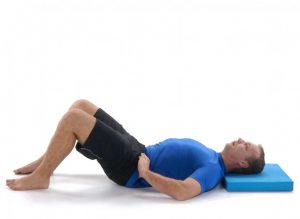
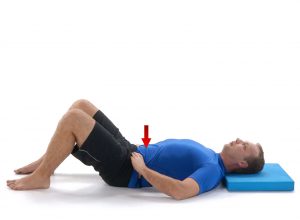
Lie on your back on a firm, flat surface with your knees bent, feet flat and head supported on a pillow if necessary.
Place your hands just above your hip bones in front and slightly toward the center of your belly on each side to monitor the contraction of the transversus abdominis muscle.
Find your neutral spine position by slowly rolling your hips backward to press your back toward the surface, then slowly rolling your hips forward, arching your back away from the surface.
Slowly move between these two positions to find the central and comfortable position. This is your neutral spine position.
Keep your neutral spine position and gently pull your belly button toward your spine (abdominal bracing). You should feel a contraction of the muscle under your fingers.
16 TA activation, four point


Take a four point position with your hands directly under your shoulders and your knees directly under your hips.
Your back must be slightly arched and your chin must be tucked in.
Maintain a steady abdominal breathing while you activate your lower abdominals (transversus abdomini) by bringing your belly button inward and by activating your pelvic floor muscles 20 to 30% of maximal contraction.
17 Abdominals on hands and toes


Start on your hands and knees with your back rounded. Then, straighten your legs to lift your knees off the floor.
Shift your body weight forward so your face is over your hands. You should feel your abdominals engage.
Keeping this position, raise one hand off the floor while preventing your trunk from twisting or turning. You should feel your abdominal engage on the opposite side.
Hold this position as prescribed.
Repeat the exercise on the other side.
18 Pelvic tilt
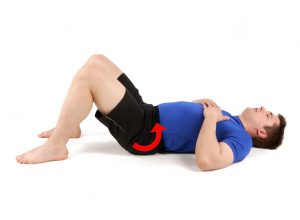

Lie on your back with your knees bent. Activate your lower abdominals (transversus abdomini) by bringing your belly button inward and by activating your pelvic floor muscles 20 to 30% of maximal contraction.Maintain a steady abdominal breathing while tilting your pelvis and flattening your back to the ground. Return slowly to the initial position and then arch your back, tilting your pelvis in the opposite direction.Return to neutral and repeat.
Colgan Osteopath in Kettering Northamptonshire
Colgan Osteopath in Hatfield, Hertfordshire
To book an appointment, call 07738493974 or book online